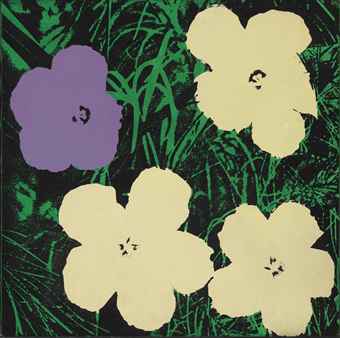Warhol Flowers, 1990
Elaine Sturtevant, an American artist born 1930 in Lakewood, Ohio, has achieved recognition for her works that consist entirely of copies of other artists' works. She lives and works in Paris.
http://en.wikipedia.org/wiki/Elaine_Sturtevant
Warhol Flowers, 1965
In 1991, Sturtevant presented an entire show consisting of her
repetition of Warhol’s ‘Flowers’ series. It was not the first time
(although what ‘first time’ means in terms of seeing and re-seeing art
is important to consider) she had investigated the flash and physics of
encountering this work. In the mid-60s, she asked Warhol for the
original silkscreen with which he had made his ‘Flowers’ - an image he
appropriated, not uninterestingly, from a Kodak ad - to make hers.
Warhol gave her the screen. At a later date, after being bombarded with
questions about his process and technique, Warhol responded: ‘I don’t
know. Ask Elaine.’ As Sturtevant puts it: ‘Warhol was very Warhol’.
This is a complicated statement. How did Warhol get to be ‘very Warhol’?
How does one come to recognise - see, consider - a painting, film , or
anything by Warhol once he and everything he’s done are slated only to
be ‘a Warhol’? It is Sturtevant who knows how to make a Warhol, not
Warhol. It is Sturtevant who allows a Warhol to be a Warhol, by
repeating him. Copy, replica, mimesis, simulacra, fake, digital
virtuality, clone - Sturtevant’s work has been for more than 40 years a
meditation on these concepts by decidedly not being any of them.
Bruce Hainley
http://www.frieze.com/issue/article/erase_and_rewind/
Warhol Flowers, 1990
A 40-year span has occurred between Sturtevant’s first remake, Warhol Flowers in 1964 and its exhibition in a major museum survey of her work in 2004 (although one must pause to reconsider how to describe what Sturtevant does, for to call it a remake, remix, or a replay would more than likely irk her). Sturtevant makes copies of art works, but she is no copyist. She appropriates, but is not an Appropriationist. She was a renegade female artist, but not a feminist. So what is this artist sine qua non all about?
Is she illustrating Baudrillard’s sense of the simulacrum, or denuding Deleuze’s thinking on difference and repetition? Is she challenging or upholding the aura of the artwork in an age of reproduction? Perhaps a Proustian sense of memory, of ‘seeing again’, lies behind it all. Or perhaps Sturtevant is working against the empiricists, eliminating the possibility of ‘seeing’ altogether. After all, it would seem that the crooked stick of humanity has never quite gone beyond the idea that ‘seeing is believing’.
Sturtevant
makes her Sturtevantian memory (or memory in motion) the subject of her
work and is antsy when anyone places her on the wrong shelf of the
categorical imperative/interrogative. When someone called her an
Appropriationist, she responded, “I am not an Appropriationist by token
of intention and meaning. I do not make copies. I am talking about the
power and the autonomy of the original and the force and pervasiveness
of art. Perhaps the brawny brains of this ‘doctor of thinkology’ have
scared off possible fans and supporters. And if Castelli could
understand enough to wheel and deal in Pop, he knew that he could never
convince his group of collectors that they should not only buy a Warhol,
Johns, or Lichtenstein, but a Sturtevant/Warhol Marilyn, a Sturtevant/
Johns Flag, or a Sturtevant/Lichtenstein Hot Dog (though Castelli
himself once acquired a Sturtevant from her Oldenburg store).
No
one has admission to her sorcery excepting the few who are well-versed
in the ideas of Deleuze and Foucault. This ‘black magic woman’ has
worked the witchery of exclusivity into her production whether she
wanted to or not. Like hearing heavy footsteps on the floor above, one
can hear, but never really know what is going on upstairs; until, that
is, one knocks on the door.
April Elizabeth Lamm
http://boone-broodthaers.blogspot.co.uk/2012/05/sturtevant-originally-published-in-art.html
Warhol Flowers, 1990
Hans Ulrich Obrist: Copy, copyright, and ready-made?
Sturtevant:
Ready-mades are such a hot topic right now. For instance, I had one
artist approach me and say she did ready-made art. I wondered how that
was possible since her art was not readymade at all. Then she said, “No.
I’m a ready-made artist.” I then wondered what that meant and how it
worked. She said, “Oh, I don’t know, my dealer told me to say that”
[laughs]. So I think we’re in a lot of trouble here. It’s a way to
attach to things – you can do this, you can do that, you can do remake,
re-copy, ready-made, or any other cliché word. In terms of copy and
copyright, it‘s impossible to have a discourse about it. You absolutely
cannot discuss copyright with lawyers because it’s a complete impasse,
and won’t even come close to a discourse or dialogue. If you start
talking to them about why copyright is no longer viable, they close the
conversation. Copyright is not copyright anymore, but more about how
this world is functioning. It’s not about the law, it’s about our way of
being. And copy has very different dynamics than something that
resembles something else. But it’s not an interesting topic anymore;
it’s not viable. But I can also say that Duchamp is not viable.
http://032c.com/2008/elaine-sturtevant/
Friday 18 October 2013
Subscribe to:
Post Comments (Atom)





No comments:
Post a Comment